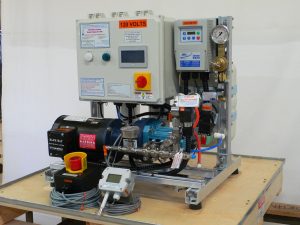A totally self-contained. ULV (ultra low volume) fogging system that siphons hydrogen peroxide solution from any source to disinfect rooms, waiting rooms and high traffic problem areas.
- Have any questions?
- 646-265-3826
- Quotes@pennvint.com
Oil Stop Valve
Upgrade Existing Separators
September 15, 2013Oil Water Separators VTC Series
September 15, 2013Choosing an Oil Stop Valve
Function
- Prevents discharge of separated oil to sewers/streams
Features
- Dependable gravity operation
- Single moving part
- Large flow capacity
- Self-opening (optional)
- No power requirement
- Corrosion resistant construction
- Flow rates to 1400 GPM through a single valve
Application Uses
 Large, unpredictable oil spills can defeat the most conservatively designed pollution control system. But while the cost of such a system can be prohibitive, the consequences of not controlling a spill can be equally catastrophic. The AFL/Clark Oil Stop Valve (OSV) is designed to solve these problems.
Large, unpredictable oil spills can defeat the most conservatively designed pollution control system. But while the cost of such a system can be prohibitive, the consequences of not controlling a spill can be equally catastrophic. The AFL/Clark Oil Stop Valve (OSV) is designed to solve these problems.
Oil Stop Valves confine even large oil spills to the premises. The OSV is available from AFL prepackaged in a fiberglass or steel catch basin or as an option on AFL oil/water separators. In addition, the OSV is available separately for installation in existing separators, catch basins or manholes.
The OSV has only one moving part, a ballasted float set at a specfic gravity between that of oil and water. When an oil spill occurs, the float loses buoyancy as the oil level increases until it finally seats itself on the discharge port. Thus, the oil spill is confined.
 The Oil Stop Valve is fabricated from non-corrosive PVC and stainless steel. Standard sizes are 4″, 6″, 8″, 10″, 12″ discharge piping. Larger piping systems can be accommodated by manifolding units together. Optional screening can be provided if necessary to prevent the dicharge of large floating solids.
The Oil Stop Valve is fabricated from non-corrosive PVC and stainless steel. Standard sizes are 4″, 6″, 8″, 10″, 12″ discharge piping. Larger piping systems can be accommodated by manifolding units together. Optional screening can be provided if necessary to prevent the dicharge of large floating solids.
Consider the OSV for those applications where oil spills are possible, but unpredictable such as electrical transformers, oil storage areas, and transportation fueling systems. The Oil Stop Valve is the most cost effective method to prevent a major disaster.

